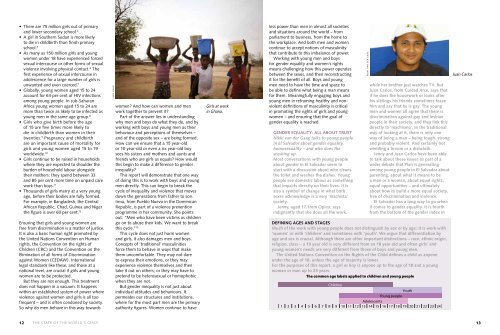Because I am a girl: The State of the World's ... - Plan Deutschland
Because I am a girl: The State of the World's ... - Plan Deutschland
Because I am a girl: The State of the World's ... - Plan Deutschland
You also want an ePaper? Increase the reach of your titles
YUMPU automatically turns print PDFs into web optimized ePapers that Google loves.
• <strong>The</strong>re are 75 million <strong>girl</strong>s out <strong>of</strong> primary<br />
and lower secondary school. 4<br />
• A <strong>girl</strong> in Sou<strong>the</strong>rn Sudan is more likely<br />
to die in childbirth than finish primary<br />
school. 5<br />
• As many as 150 million <strong>girl</strong>s and young<br />
women under 18 have experienced forced<br />
sexual intercourse or o<strong>the</strong>r forms <strong>of</strong> sexual<br />
violence involving physical contact. 6 <strong>The</strong><br />
first experience <strong>of</strong> sexual intercourse in<br />
adolescence for a large number <strong>of</strong> <strong>girl</strong>s is<br />
unwanted and even coerced. 7<br />
• Globally, young women aged 15 to 24<br />
account for 64 per cent <strong>of</strong> HIV infections<br />
<strong>am</strong>ong young people. In sub-Saharan<br />
Africa young women aged 15 to 24 are<br />
more than twice as likely to be infected as<br />
young men in <strong>the</strong> s<strong>am</strong>e age group. 8<br />
• Girls who give birth before <strong>the</strong> age<br />
<strong>of</strong> 15 are five times more likely to<br />
die in childbirth than women in <strong>the</strong>ir<br />
twenties. 9 Pregnancy and childbirth<br />
are an important cause <strong>of</strong> mortality for<br />
<strong>girl</strong>s and young women aged 15 to 19<br />
worldwide. 10<br />
• Girls continue to be raised in households<br />
where <strong>the</strong>y are expected to shoulder <strong>the</strong><br />
burden <strong>of</strong> household labour alongside<br />
<strong>the</strong>ir mo<strong>the</strong>rs: <strong>the</strong>y spend between 33<br />
and 85 per cent more time on unpaid care<br />
work than boys. 11<br />
• Thousands <strong>of</strong> <strong>girl</strong>s marry at a very young<br />
age, before <strong>the</strong>ir bodies are fully formed.<br />
For ex<strong>am</strong>ple, in Bangladesh, <strong>the</strong> Central<br />
African Republic, Chad, Guinea and Niger<br />
<strong>the</strong> figure is over 60 per cent. 12<br />
Ensuring that <strong>girl</strong>s and young women are<br />
free from discrimination is a matter <strong>of</strong> justice.<br />
It is also a basic human right promoted by<br />
<strong>the</strong> United Nations Convention on Human<br />
rights, <strong>the</strong> Convention on <strong>the</strong> rights <strong>of</strong><br />
Children (CRC) and <strong>the</strong> Convention on <strong>the</strong><br />
Elimination <strong>of</strong> all forms <strong>of</strong> Discrimination<br />
against Women (CEDAW). International<br />
legal standards like <strong>the</strong>se, and those at a<br />
national level, are crucial if <strong>girl</strong>s and young<br />
women are to be protected.<br />
But <strong>the</strong>y are not enough. This treatment<br />
does not happen in a vacuum. It happens<br />
within an established system <strong>of</strong> power where<br />
violence against women and <strong>girl</strong>s is all too<br />
frequent – and is <strong>of</strong>ten condoned by society.<br />
So why do men behave in this way towards<br />
J a n e H a h n<br />
women? And how can women and men<br />
work toge<strong>the</strong>r to prevent it?<br />
Part <strong>of</strong> <strong>the</strong> answer lies in understanding<br />
why men and boys do what <strong>the</strong>y do, and by<br />
working with boys and young men as <strong>the</strong>ir<br />
behaviour and perceptions <strong>of</strong> <strong>the</strong>mselves –<br />
and <strong>of</strong> <strong>the</strong> opposite sex – are being formed.<br />
How can we ensure that a 15 year-old<br />
or 10 year-old or even a six year-old boy<br />
sees his sisters and mo<strong>the</strong>rs and aunts and<br />
friends who are <strong>girl</strong>s as equals? How would<br />
this begin to make a difference to gender<br />
inequality?<br />
This report will demonstrate that one way<br />
<strong>of</strong> doing this is to work with boys and young<br />
men directly. This can begin to break <strong>the</strong><br />
cycle <strong>of</strong> inequality and violence that moves<br />
down <strong>the</strong> generations from fa<strong>the</strong>r to son.<br />
Irma, from Pueblo Nuevo in <strong>the</strong> Dominican<br />
Republic, is part <strong>of</strong> a violence prevention<br />
progr<strong>am</strong>me in her community. She points<br />
out: “Men who have been victims as children<br />
go on to abuse <strong>the</strong>ir kids. We want to break<br />
this cycle.” 13<br />
This cycle does not just harm women<br />
and <strong>girl</strong>s, it also d<strong>am</strong>ages men and boys.<br />
Concepts <strong>of</strong> ‘traditional’ masculinities<br />
force <strong>the</strong>m to behave in ways that make<br />
<strong>the</strong>m uncomfortable. <strong>The</strong>y may not dare<br />
to express <strong>the</strong>ir emotions, or <strong>the</strong>y may<br />
experience violence <strong>the</strong>mselves and <strong>the</strong>n<br />
take it out on o<strong>the</strong>rs; or <strong>the</strong>y may have to<br />
pretend to be heterosexual or homophobic<br />
when <strong>the</strong>y are not.<br />
But gender inequality is not just about<br />
individual attitudes and behaviours. It<br />
permeates our structures and institutions,<br />
where for <strong>the</strong> most part men are <strong>the</strong> primary<br />
authority figures. Women continue to have<br />
Girls at work<br />
in Ghana.<br />
less power than men in almost all societies<br />
and situations around <strong>the</strong> world – from<br />
parli<strong>am</strong>ent to business, from <strong>the</strong> home to<br />
<strong>the</strong> workplace. And both men and women<br />
continue to accept notions <strong>of</strong> masculinity<br />
that contribute to this imbalance <strong>of</strong> power.<br />
Working with young men and boys<br />
for gender equality and women’s rights<br />
means challenging how this power operates<br />
between <strong>the</strong> sexes, and <strong>the</strong>n reconstructing<br />
it for <strong>the</strong> benefit <strong>of</strong> all. Boys and young<br />
men need to have <strong>the</strong> time and space to<br />
be able to define what being a man means<br />
for <strong>the</strong>m. Meaningfully engaging boys and<br />
young men in refr<strong>am</strong>ing healthy and nonviolent<br />
definitions <strong>of</strong> masculinity is critical<br />
in promoting <strong>the</strong> rights <strong>of</strong> <strong>girl</strong>s and young<br />
women – and ensuring that <strong>the</strong> goal <strong>of</strong><br />
gender equality is reached.<br />
Gender equality: all about trust<br />
Nikki van der Gaag talks to young people<br />
in El Salvador about gender equality,<br />
homosexuality – and who does <strong>the</strong><br />
washing up.<br />
Most conversations with young people<br />
about gender in El Salvador seem to<br />
start with a discussion about who cleans<br />
<strong>the</strong> toilet and washes <strong>the</strong> dishes. Young<br />
people see domestic labour as something<br />
that impacts directly on <strong>the</strong>ir lives. It is<br />
also a symbol <strong>of</strong> change in what both<br />
sexes acknowledge is a very ‘machista’<br />
society.<br />
Jenny, aged 17, from Opico, says<br />
indignantly that she does all <strong>the</strong> work,<br />
1 2 3 4 5 6 7 8 9 10<br />
N i k k i v a n d e r G a a g<br />
while her bro<strong>the</strong>r just watches TV. But<br />
Juan Carlos, from Cuidad Arce, says that<br />
if he does <strong>the</strong> housework or looks after<br />
his siblings his friends sometimes tease<br />
him and say that he is gay. <strong>The</strong> young<br />
men and women all agree that <strong>the</strong>re is<br />
discrimination against gay and lesbian<br />
people in <strong>the</strong>ir society, and <strong>the</strong>y link this<br />
directly to ‘machismo’. In <strong>the</strong> traditional<br />
way <strong>of</strong> looking at it, <strong>the</strong>re is only one<br />
way <strong>of</strong> being a man – being tough, strong<br />
and probably violent. And certainly not<br />
wielding a broom or a dishcloth.<br />
Jenny and Juan Carlos have been able<br />
to talk about <strong>the</strong>se issues as part <strong>of</strong> a<br />
wider debate that <strong>Plan</strong> is generating<br />
<strong>am</strong>ong young people in El Salvador about<br />
parenting, about what it means to be<br />
a man or a woman, about equal rights,<br />
equal opportunities – and ultimately<br />
about how to build a more equal society,<br />
free <strong>of</strong> discrimination and violence.<br />
El Salvador has a long way to go when<br />
it comes to gender equality. It is fourth<br />
from <strong>the</strong> bottom <strong>of</strong> <strong>the</strong> gender index in<br />
Defining ages and stages<br />
Much <strong>of</strong> <strong>the</strong> work with young people does not distinguish by sex or by age: it is work with<br />
‘women’ or with ‘children’ and sometimes with ‘youth’. We argue that differentiation by<br />
age and sex is crucial. Although <strong>the</strong>re are o<strong>the</strong>r important distinctions – race, ethnic origin,<br />
religion, class – a 10 year old is very different from an 18 year old and <strong>of</strong>ten <strong>girl</strong>s’ and<br />
young women’s needs are very different from those <strong>of</strong> boys and young men.<br />
<strong>The</strong> United Nations Convention on <strong>the</strong> Rights <strong>of</strong> <strong>the</strong> Child defines a child as anyone<br />
under <strong>the</strong> age <strong>of</strong> 18, unless <strong>the</strong> age <strong>of</strong> majority is lower.<br />
For <strong>the</strong> purposes <strong>of</strong> this report, a <strong>girl</strong> or boy is anyone up to <strong>the</strong> age <strong>of</strong> 18 and a young<br />
woman or man up to 25 years.<br />
<strong>The</strong> common age labels applied to children and young people<br />
Children<br />
Youth<br />
Young people<br />
Adolescents<br />
11 12 13 14 15 16 17 18 19 20 21 22 23 24<br />
Juan Carlos<br />
12 <strong>the</strong> s tate <strong>of</strong> <strong>the</strong> world’s <strong>girl</strong>s 13



